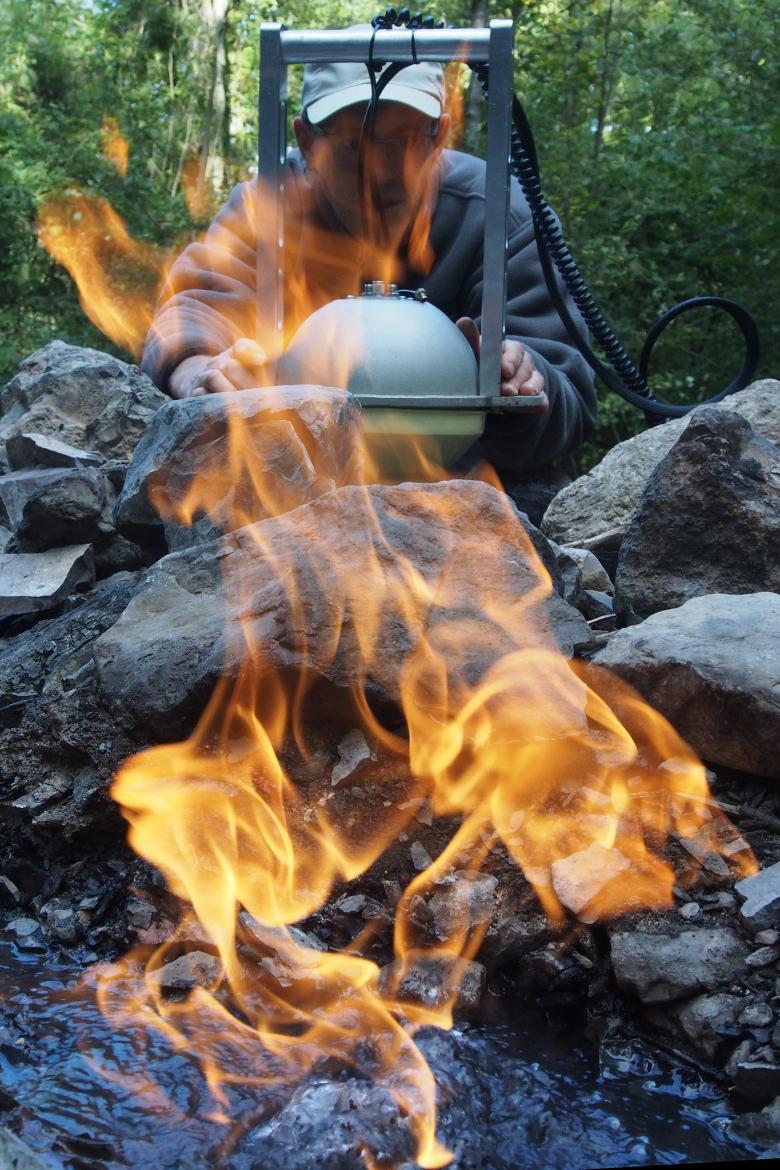
Mesures de flux de gaz du sol dans les environs de la Fontaine Ardente du Gua (Isère).
© BRGM - Wolfram Kloppmann
Natural gas remains a widely used transitional fossil fuel as the world turns away from coal to less polluting energy sources. While large conventional reserves exist on various continents, a significant portion of this natural gas has been produced since the beginning of this century from so-called unconventional hydrocarbon reservoirs such as black shales, particularly in North America.
Historically, three main sources of natural gas have been distinguished. Microorganisms that feed on organic matter produce so-called microbial gas formed in reducing, low temperature environments. When black shales, during their geological history, are buried at depths where high temperatures and pressures prevail, the same organic matter decomposes into gas termed thermogenic. Finally, when certain rocks are altered in contact with water, complex chemical reactions involving natural hydrogen produce what is called abiotic gas.
The study undertaken by BRGM researchers and Canadian and Swiss experts shows that there is a fourth source of natural gas, generated by the radiolysis of organic matter in shales. In addition to organic matter, black shales frequently contain radioelements such as uranium. Their natural radioactivity can interact, often over hundreds of millions of years, with the organic matter to produce this new type of "radiolytic" gas containing methane, ethane and propane which, without being radioactive itself, mixes within the shales with thermogenic and, eventually, microbial gases. At first glance, this gas is not different from other types of natural gas. It is only a detailed analysis of its chemical nature and carbon isotopic signatures that has allowed the research team to demonstrate its existence in numerous shale formations throughout the world.
A study conducted within the framework of the European H2020 SECURe project
Conducted within the framework of the European SECURe project (Horizon 2020 program), this study could, in addition to providing a deeper understanding of the formation of natural gases from unconventional reservoirs, help to better determine the sources of possible gas migration in near-surface geological environments. Indeed, when groundwater and soil monitoring in the vicinity of shale gas operations reveals high methane concentrations, these may be linked to gas migration from various underlying geological formations but also to the environmental background. In particular, it may be microbial gas generated near the surface, unrelated to the natural gas being exploited. Taking into consideration the radiolytic origin of some gas in certain shale formations, allows for a better identification of deep reservoir gas, which is an important issue for the evaluation of the potential risks and impacts of natural gas exploitation from unconventional reservoirs.
Reference
Naumenko-Dèzes M., Kloppmann W., Blessing M., Bondu R., Gaucher E., Mayer B. (2022) Natural gas of radiolytic origin: An overlooked component of shale gas. "Proceedings of the National Academy of Sciences” (PNAS)
About PNAS
Founded in 1914, PNAS (Proceedings of the National Academy of Sciences) is the official journal of the United States Academy of Sciences. Considered one of the most prestigious multidisciplinary peer-reviewed scientific media, it publishes several thousand articles per year on cutting-edge research.
Isotopic expertise at BRGM
Since its beginnings in the 1940s, the study of isotopes has continued to develop in the research community. The same chemical element can have different atomic masses (for the same number of protons, the number of neutrons can vary): these are its isotopes. Some atoms are stable, while others, which are radioactive, disintegrate over time. The ability to distinguish between these isotopes facilitates geological dating and also makes it possible to trace the origin and transformations of elements in the subsoil or in water. Within its scientific and technical center at La Source, BRGM benefits from a very complete analytical infrastructure for the isotopic study of a large number of chemical elements.
To find out more
Press contact








